In the world's oceans, few predators command as much fear and fascination as the notorious bull shark (Carcharhinus leucas). Renowned for its aggressive nature and adaptability to both saltwater and freshwater environments, the bull shark stands out as a formidable force in marine ecosystems. However, as we explore the depths of its behavior and habitat, it becomes apparent that understanding and respecting these apex predators are crucial for mitigating potential risks to human safety.
The Aggressive Reputation: Bull sharks have earned a fearsome reputation as one of the most aggressive shark species, often contributing to a higher number of attacks on humans, particularly in coastal areas. Their unpredictable nature, coupled with the ability to thrive in diverse environments, makes them a potential threat near shorelines and shallow waters. While encounters between bull sharks and humans are relatively rare, the severity of their attacks has solidified their status as dangerous adversaries.
Adaptability in Saltwater and Freshwater: What sets the bull shark apart from its marine counterparts is its remarkable ability to navigate both salt and freshwater habitats. This adaptability allows bull sharks to venture into estuaries, rivers, and canals, creating opportunities for encounters with humans in unexpected locations. Their presence in these diverse environments reflects their versatility as hunters, as they pursue an array of prey, including fish, sea turtles, and marine mammals.
The Danger Lurking in Coastal Areas: Coastal areas, where estuaries meet the open sea, become hotspots for potential human-shark interactions. Bull sharks often frequent these regions, driven by the abundance of prey and the dynamic nature of coastal ecosystems. The proximity to popular recreational areas intensifies the perceived threat, prompting concerns about safety among beachgoers and water enthusiasts.
Mitigating Risks Through Awareness: While bull sharks' aggressive tendencies may instill fear, it is essential to emphasize that attacks on humans are relatively infrequent. Understanding their behavior, habitat preferences, and seasonal patterns can empower individuals to take appropriate safety measures. Being informed and aware of potential dangers is the first line of defense against shark encounters.
Safety Measures for Human Coexistence:
-
Education and Awareness: Public awareness campaigns play a pivotal role in educating communities about bull shark behavior, dispelling myths, and providing guidelines for safe coexistence.
-
Monitoring and Surveillance: Implementing effective surveillance measures in popular coastal areas enables authorities to detect shark activity promptly and take necessary precautions to ensure public safety.
-
Early Warning Systems: Developing and employing early warning systems can alert beachgoers and water enthusiasts to the presence of sharks in the vicinity, allowing them to make informed decisions about water activities.
-
Designated Swimming Areas: Establishing marked swimming zones and enforcing guidelines for water activities help minimize the risk of shark encounters by directing humans away from potential hotspots.
-
Use of Deterrent Technologies: Exploring and adopting non-lethal shark deterrent technologies can serve as an additional layer of protection for humans and reduce the likelihood of shark attacks.
Navigating Waters Safely with Bull Sharks in Mind: While bull sharks undeniably possess formidable characteristics that demand respect, coexisting with these predators is feasible through informed decision-making and appropriate safety measures. By understanding their behavior and implementing proactive strategies, we can significantly reduce the risk of shark encounters. The balance between human recreation and the natural habitats of bull sharks can be maintained, fostering a harmonious relationship that ensures the safety of both species.
